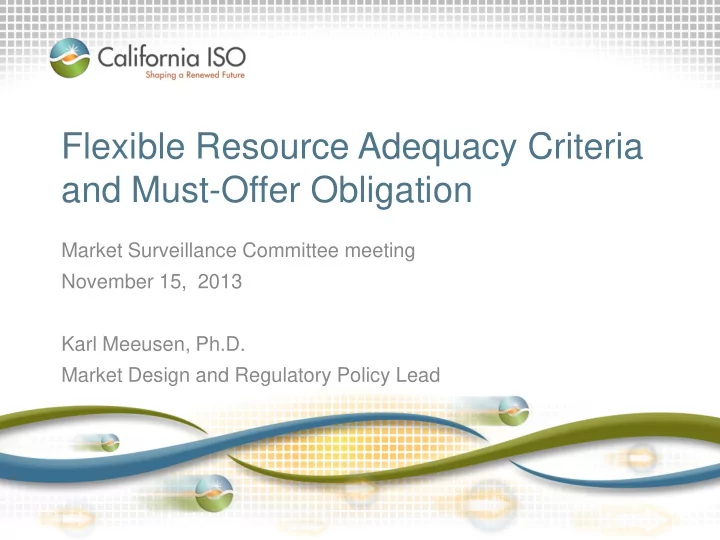

Flexible Resource Adequacy Criteria and Must-Offer Obligation Market Surveillance Committee meeting November 15, 2013 Karl Meeusen, Ph.D. Market Design and Regulatory Policy Lead
Flexible capacity requirement is split into its two component parts to determine the allocation • Maximum of the Most Severe Single Contingency or 3.5 percent of forecasted coincident peak – Allocated to LRA based on peak-load ratio share • The maximum 3-hour net load ramp using changes in – Load – Wind output – Solar PV – Solar thermal – Distributed energy resources Page 2
The ISO will decompose the largest 3-hour net load ramp into five components to determine the LRA’s final allocation Allocation = Δ Load – Δ Wind Output – Δ Solar PV – Δ Solar Thermal Δ Load – LSE’s average contribution to load change during top five • daily maximum three-hour net-load ramps within a given month from the previous year x total change in ISO load Δ Wind Output – Percent of total wind contracted x total change in wind • output Δ Solar PV – Percent of total solar PV contracted x total change in solar • PV output Δ Solar Thermal – Percent of total solar thermal contracted x total • change in solar thermal output 3-hour maximum net-load ramp used is coincident 3-hour maximum ramp Page 3
ISO proposes to allocate Δ Load component based on an LSE contribution to top five historical peak 3-hour net-load ramps • Allocation is based on each LSE’s contribution to load change during the peak net-load ramps • Uses the LSE’s contribution during the five maximum 3- hour net-load ramps, not monthly averages – Helps address uncertainty in forecasting and anomalous load changes – Maintains focus on peak net-load ramping events Page 4
PG&E’s proposal to allocate load use non-coincident peak load ramps • Calculate each LSE’s single largest 3-hour maximum load ramp (non-coincident) in MWs for each month using the previous two years of historical loads • Calculate monthly percentage allocators for each LSE by dividing an LSE’s own 3-hour ramp requirement by the sum of the 3 LSEs’ 3-hour ramp requirements • Use the resulting 12 percentages to allocate the CAISO’s monthly 3-hour max net load ramp requirements caused by changes in load Page 5
An example comparing the ISO and PG&E proposals LSE’s maximum LSE’s share of System’s load ramp LSE’s monthly LSE’s monthly Difference Between 3-hour load total LSE load coincident with allocation of contribution to PG&E proposal and change in ramps in month system’s maximum 3- load for system’s maximum 3- ISO’s proposal month (non- hour net-load ramp in flexible hour net-load ramp in coincident) month requirement month (coincident) LSE 1 2,000 MW 2,000 MW/8,000 25% * 5,000 1,250 MW or 25% 0 MW MW = 25% MW = (Day 2, HE 1,250 MW 14-HE17) LSE 2 3,000 MW or 60% -1175 MW 3,000 MW 3,000 MW/8,000 37.5% * MW = 37.5% 5,000 MW = (Day 6, HE 1,875 MW 15-HE18) 5,000 MW (Day 6, LSE 3 1,000 MW 1,000 MW/8,000 12.5% * -150 MW or -3% 775 HE 15-HE 18) MW =12.5% 5,000 MW = (Day 15, HE 625 MW 14-HE17) LSE 4 2,000 MW 2,000 MW/8,000 25% * 5,000 900 MW or 18% 350 MW MW = 25% MW = (Day 30, HE 1,250 MW 14-HE17) Total 8,000 MW Page 6
The ISO proposal is consistent with cost causation principles • Flexible capacity requirements set based on coincident peak ramps, allocation should also be base on the based on coincident peak ramps – The ISO proposal is consistent with causation principles • Not clear that PG&E’s proposal resolves all free-rider problems – May just shift the ramping requirement to LSEs that ramp in non-peak ramping times • The ISO’s proposed methodology is consistent with how generic RA is currently allocated Page 7
Recommend
More recommend